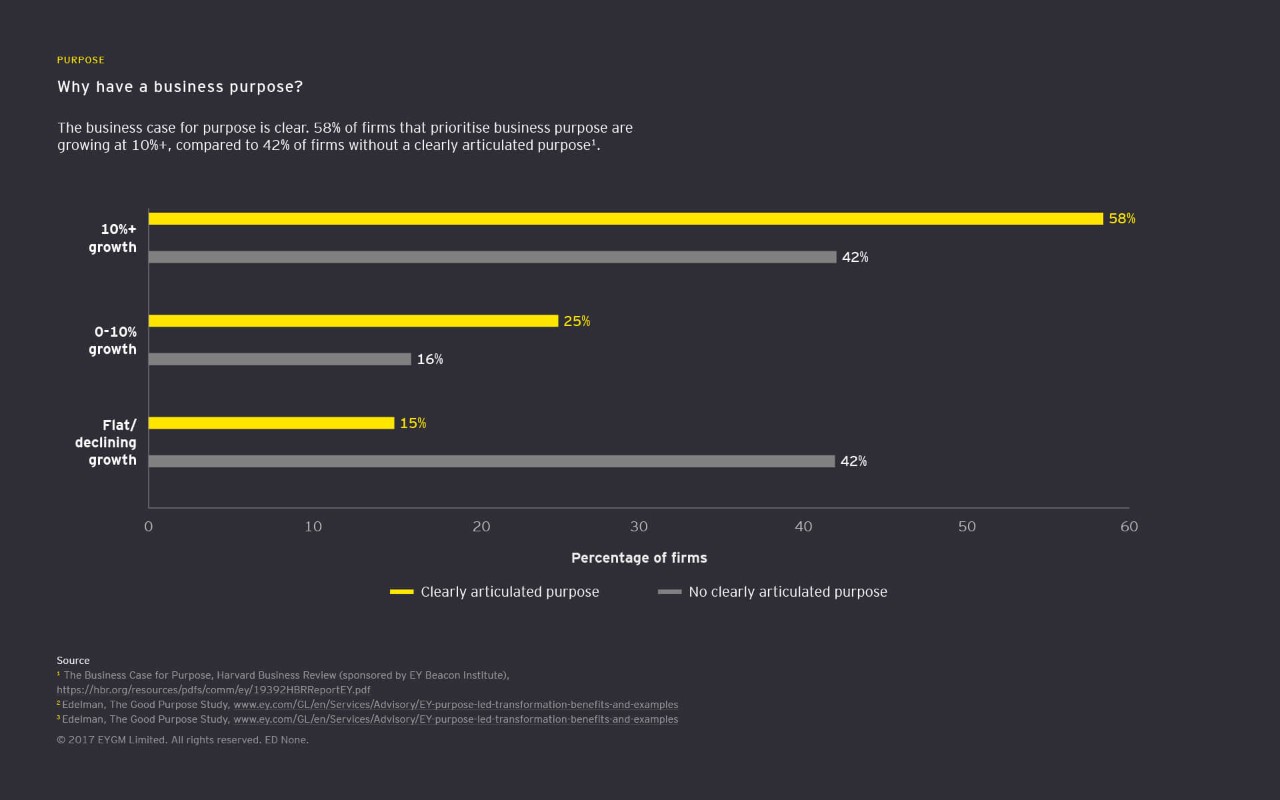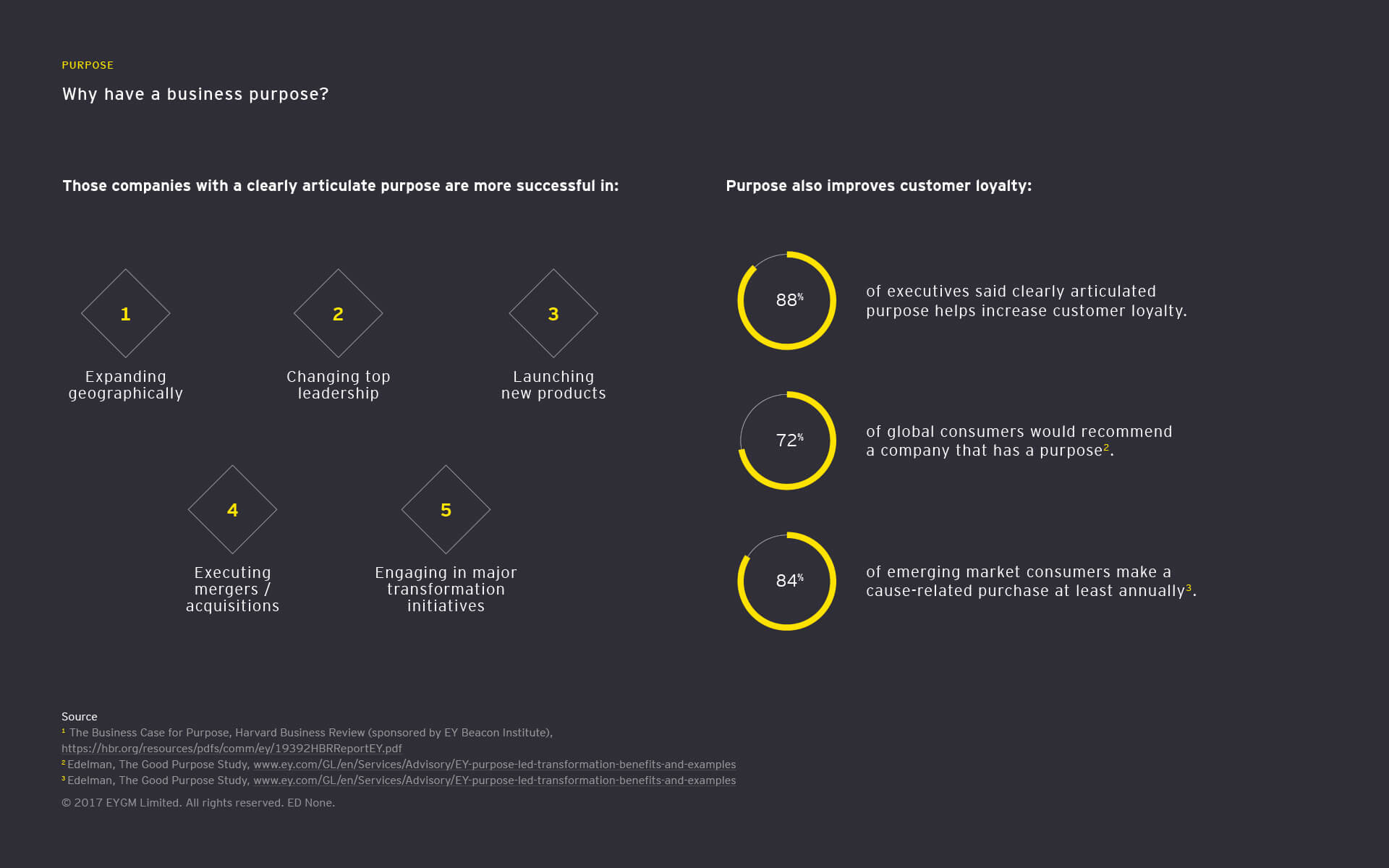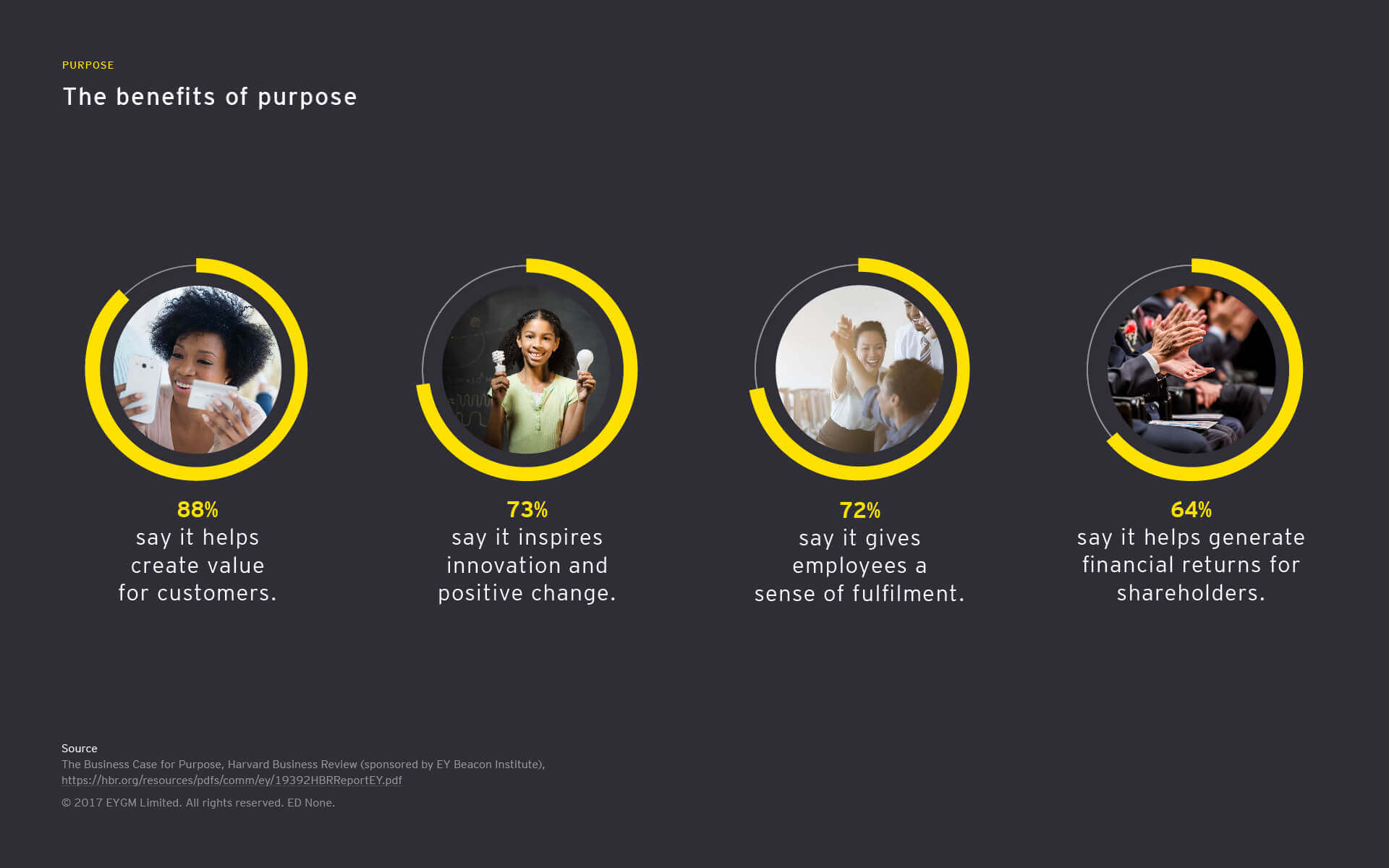

Chapter 1
What is purpose and why do we need it?
For purpose to really matter, it needs to go beyond an initiative that sits on the margins of the organization.
The idea that a company should stand for something bigger than profit has a long history in business. But in the last few years, it’s become central to the public dialogue,” says Weinberger. “The hard part – the real test of an organization’s purpose – is figuring out how to make it more than just words in a memo. For purpose to really matter, it needs to go beyond an initiative that sits on the margins of the organization.”
Exploring the subject in some depth, we have come to define corporate purpose as an aspirational reason for being that is grounded in humanity and inspires a call to action. But this is also starting to shift – to a broad, human-centered, socially-engaged conception of purpose that seeks to create value for multiple stakeholders. While many organizations claim to have a purpose, we have started to define this new, deeper articulation of intent as Purpose (with a capital P).
6 reasons why purpose is becoming more important
The idea of corporate purpose is not new but has reentered public discourse in recent years and even begun to eclipse related topics like ‘sustainability’. A study conducted by EY and Oxford University Saïd Business School found public conversation about purpose increased fivefold between 1995 and 2014.
Of the recent global changes that have led organizations to reflect on and reintroduce purpose into the corporate lexicon, six forces in particular are challenging companies’ old sense of identity and operating models — forcing them to rethink value and how it is created.
1. The Trust deficit
One legacy of the 2008 banking crisis is a dwindling sense of public trust in corporations, across geographies and generational lines, with the distribution of wealth and opportunity being increasingly perceived as unequal and unfair. Younger generations in particular tend to trust business less than their predecessors. In addition, trust in CEOs as individuals is also in decline. “In the past decade, the top 1% of earners have seen a disproportionate amount of wealth accumulation. That’s not sustainable,” says Weinberger. “Since economic growth is largely driven by consumption, if we expanded income and opportunities to the broader population, we’d see far more robust global economic growth.”
2. Sustainability
With climate change currently high on the societal agenda, more companies are under public and regulatory scrutiny about their environmental impact. Such pressure is forcing executives to re-evaluate how they produce, consume and supply goods and services, to mitigate risks and make operations, supply chains, products and services more socially and environmentally sustainable. And businesses are also seeing the importance of acting from an economic perspective, with evidence mounting that climate change could severely damage the global economy – one study predicting global losses of as much as $72 trillion.
Related article
We need to listen. We need to act.
Beth Brooke-Marchiniak,
Global Vice-Chair – Public Policy, EY
3. Social inequality
The world is getting richer, but inequality across the globe is on the rise – currently at an historic high in fact. Of the world’s population, 1% now controls more than 50% of the planet’s wealth. The pay gap between corporate executives and employees is also widening. Peter Drucker, the late management thinker, once warned that a CEO-to-worker pay ratio of more than 20 to 1 would “increase employee resentment and decrease morale.” In some US organizations, as of 2014, that ratio was 350 to 1.
This has not gone unnoticed, with anger at this inequality being expressed at ballot boxes around the world. “The economic inequality message has been clear,” says Beth Brooke-Marchiniak, Global Vice-Chair – Public Policy, EY. “In the aftermath of 2016, we have societies pulling apart, finding it hard to resist trends toward nationalism and a rejection of those who are different. We need to listen. We need to act.”
4. Diminishing brand control, rising social media
In recent years businesses have lost some control over their brands to customers and the wider public. The public has proven adept at harnessing social media to propagate their influence and opinions on unfulfilled brand promises around the world in seconds – faster and more effectively than any news organization could. The ease with which opinions can be expressed makes creating a positive first impression more important than ever. This is part of the reason why “entrepreneurs are increasingly tapping into their sense of purpose to enhance their businesses’ reputations,” says Keller. “They want the world to know that while they value a healthy bottom line, profit is a positive by-product of what they do, not the only reason for doing it."
5. Demand for longer-term thinking
The public is now asking for more from companies than a commitment to short-term profitability. A growing number believe that companies have an obligation to address long-term global environmental and social challenges – the so-called Triple Bottom Line. Executives are also trying to consider long-term consequences despite many short-term pressures: one report indicated that 40% of CEOs surveyed said short-term shareholders constitute the greatest threat to corporate values. After all, says Weinberger, “much of a company’s actual value is tied into things like brand, talent, and intellectual capital – the assets that are crucial to creating value in both the short and long term.”
6. Digitization – threats and opportunities
It took over a decade for mobile broadband to reach two billion people. By 2021 that number could almost quadruple to 7.7 billion. This instantaneous interconnectedness between stakeholders and the increase of powerful, real-time data analysis will create new opportunities for businesses to know and serve customers better. But it will also bring in new ways for customers to spot any gaps between a company’s image and its actions in reality. “As data and digital technology affect every sector, businesses are under tremendous pressure to innovate, says David Jensen, Global Disruptive Innovation and EY wavespace (TM) Leader, EY. “Predicting the future is impossible, but when an organization can articulate and activate a higher purpose it has a better opportunity to shape the future of itself and its marketplace.”
Combined, these six forces mean that many employees, customers, investors, communities and other stakeholders are asking profound questions about the structure of society and the role of the corporation within it. And while change is a perpetual feature of life and business, technology and science are pushing the pace and extent of change like never before.
Instead, grasping the core reason an organization’s existence and seeing how that sits within the wider world can be a more constructive way to address disruption.

Chapter 2
Purpose pays
The business case for purpose.
The need for purpose may be driven by global socio-economic factors seemingly beyond the control of corporations. But there is an upside: much of the discussion about purpose suggests that companies perform better if they have a clear sense of purpose. Purpose-driven companies make more money, have more engaged employees and more loyal customers, and are even better at innovation and transformational change.
Research by author Raj Sisodia, for the second edition of his bestseller Firms of Endearment, found that companies that operate with a clear and driving sense of purpose, beyond the goal of just making money, outperformed the S&P 500 by a factor of 14 between 1998 and 2013. Three quarters of executives of Purposeful companies reported that the integration of Purpose creates value in the short-term, as well as over the long run for their companies, according to the findings of another recent EY Beacon Institute report.
Developing a cohering purpose – such as community growth, poverty reduction, environmental friendliness or simply spreading happiness – at the core of business strategy influences decision-making, inspires employees and customers, and builds trust – an increasingly essential ingredient for any successful organization.
“The sense of being part of something greater than yourself can lead to high levels of engagement, high levels of creativity and the willingness to partner across functional and product boundaries within a company, which are hugely powerful,” said Rebecca Henderson, the John and Natty McArthur University Professor at Harvard Business School. “Once they’re past a certain financial threshold, many people are as motivated by intrinsic meaning and the sense that they are contributing to something worthwhile as much as they are by financial returns or status.”
A Harvard Business Review-EY Beacon Institute survey sought to understand why, and more importantly, how, companies are employing purpose to guide and lend impetus to their transformations.
Companies with a strong sense of purpose are able to transform and innovate better. Executives who treat purpose as a core driver of strategy and decision-making reported greater ability to drive successful innovation and transformational change and deliver consistent revenue growth: 53 percent of executives who said their company has a strong sense of purpose (prioritizers) said their organization is successful with innovation and transformation efforts, compared with 31 percent of those trying to articulate a sense of purpose (developers) and 19 percent of the companies who have not thought about it at all (laggards).


You can’t just adopt it…it has to be driven, operationally and in depth, by the CEO and the top leadership team
Saying versus doing
Given the high level of consensus around purpose and the reported results, why aren’t more companies motivating employees, attracting customers and aligning suppliers with a strong purpose?
Setting a goal and achieving it are different things. The research from Harvard Business Review Analytic Services and the EY Beacon Institute suggests that, for most companies, there is a significant gap between the belief that purpose should be integrated into an organization and their ability to actually do so. This holds true for a variety of functions and activities. Across a number of industries, the biggest gaps in ideal versus actual purpose are in leadership development and training, performance metrics and rewards, and talent management.
“You can’t just adopt it…it has to be driven, operationally and in depth, by the CEO and the top leadership team,” says Michael Beer, the Cahners-Rabb Professor of Business Administration, Emeritus, at Harvard Business School. “That takes a lot of skill and understanding to do well, which is why so few companies can really pull it off.”
Related article

Chapter 3
Using purpose to enable success
Five ways purpose can transform a business and motivate employees.
CEOs are currently facing a barrage of competing pressures, some old such as the relatively short-term demands of shareholders and markets, alongside newer challenges such as industry disruption and the ever-louder calls for business to show itself as willing and able to address global challenges, like food security and sustainability.
And to address these pressures, companies need to harness the energies of their staff, to engage them to grow and innovate. This is why purpose is so valuable. Here are five ways in which purpose can help to motivate employees and transform a business, taken from the EY Beacon Institute’s The State of the Debate on Purpose:
1. Strategic clarity
“Having a strong purpose can hone your strategic response,” says Keller. “Rather than being sucked into focusing myopically on hitting the numbers for the financial quarter, purpose can keep organizations focused on driving longer term, sustainable value.” Purpose also works as a means of setting boundaries for what an organization will and will not do as part of its growth strategy. In addition, particularly when addressing complexity, purpose can serve as a lens through which to view the big strategic picture, rather than through silos.
All of these are particularly prevalent in times of transformation. A company which has been through this purposeful transformation is Johnson Controls. Going through the largest overhaul in its own long history, Johnson Controls decided to spin off its successful automotive business. According to Kim Metcalf-Kupres, Chief Marketing Officer, purpose has been a key driver behind this decision:
“The heart of our motivation and inspiration is really to find and stick to what Johnson Controls is good at. The purpose behind our company has really been captured in a vision that we’ve used for many years about creating a more comfortable, safe and sustainable world. Our strategies have evolved with that vision in mind. And as we look for the next century and the megatrends that are driving the world, we think the things that we bring to the world are very relevant. As we look at the makeup of the company and the implications for us as an organization, that’s challenged us in this age of activism to really understand what fits in our core and what does not.
2. Innovation
As well as driving incremental improvements to products and services, purpose can inspire original ideas and creativity in an organization. Guided by purpose, employees can be empowered to recast themselves as problem solvers and value providers. As many as 63.4% of executives surveyed by the Economist Intelligence Unit(supported by EY) said a sense of purpose helps them innovate and better able to disrupt or respond to disruption. Purpose can also act as a foil to short-term thinking, and as a means of opening up the creative process across the company and beyond. Electric car pioneer Tesla is a case in point, sharing its patent portfolio with the world.
“When people understand their organization’s values, they are engaged and inspired to work together to promote those values, says Jensen. “Purpose can be the ‘common denominator’ that allows organizations (even competitors, in some cases) to collaborate with each other (and their customers) on new solutions while achieving their common goals.”
3. Transformation
Purpose provides an antidote to using fear when it comes to managing organizational transformation. Instead of anchoring the need for change to a fight or flight scenario – which runs the risk of demotivating employees – tying change to the company purpose can help staff see that the short-term changes relate to long-term strategy.
“Most change initiatives seek to create a sense of crisis or urgency,” says Keller. “But there is a need to balance the burning platform with a burning ambition: creating a compelling ‘run to’ vision that is magnetic and can help break through fears and inertia.”
A clear sense of purpose can also be used as a force to guide the company through change as external pressures demand new ways of value creation. “By encouraging company leaders to focus on the horizon, purpose helps them consider their internal systems holistically,” says Keller. But the work of transformation in an age of disruption is continual: “Even after the company is fully aligned behind a compelling purpose, leaders must continue to reinforce it from the top.”
There is a need to balance the burning platform with a burning ambition: create a compelling ‘run to’ vision that’s magnetic and can help break through fears and inertia.
Valerie Keller,
EY Beacon Institute Global Leader
4. Human nature
Purpose can be used to tap into our basic human need to be part of something greater than ourselves – to contribute to a wider group or bigger goal. “Behavioral science research suggests that it really doesn’t take much for each of us to reconnect to our sense of purpose — and reap the benefits of doing so,” says Keller. “Even a brief moment of reflection on a “personal why” can help us rise to a challenge by immediately boosting our performance and resilience.”
Purpose can also be harnessed to integrate diverse global teams in new ways, helping them to focus on and reach a common goal – something that’s increasingly important as organizations try to deal with disruption. “There’s no other answer to how to work through disruption than to get a lot of different points of view and be able to listen to them and move those ideas forward,” says Nancy A. Altobello, Global Vice Chair — Talent at EY. Without a shared purpose, though, it can be hard to bring diverse teams together for maximum impact.
5. Building bridges
Purpose can be deployed as a force to promote and create better alliances, in the interests of a single compelling aim. “By showing where people and organizations share common ground, purpose also helps build bridges, across business functions within organizations and between different organizations,” says Keller.
Companies can assess their potential for collaboration with a particular group or company by looking for some common ground in their purposes. For one executive, speaking to EY, purpose is “a guiding force that tells everybody how to interact with you and what’s important to you, so that you’re driving your company forward much more strategically. From an external lens, you’re telling people how to collaborate with you and what’s important.”

Purpose as a guiding light through uncertain times
“Now, more than ever, having the proverbial “North Star” is critical to an organization’s ability to navigate disruption,” says Keller. Truly integrating purpose into strategic, daily decisions and actions is a critical part of attracting, motivating and retaining key staff. Any dissonance between rhetoric and reality will discourage, demotivate and eventually deter individuals, and this could damage a company’s reputation over time.
This link between purpose, authenticity and trust is important to emphasize if a company is to improve, not just safeguard, its performance and standing in the eyes of shareholders and society alike.
“A clear purpose, based on human values – that is authentic and consistent with businesses’ actions – is a foundation stone upon which reputation and performance are built,” says Keller. “Spending the time to put purpose at the core and to live it across every facet of the enterprise powers the sustainable growth all business leaders seek.”
Summary
A sense of purpose should be at the center of a company’s strategy for growth.


